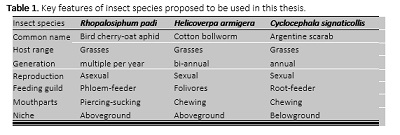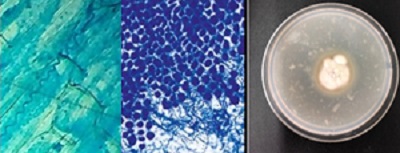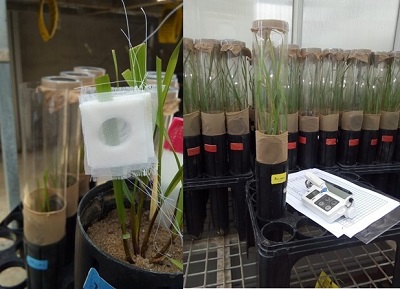Doctor Ximena Cibils-Stewart
Candidature
Graduated PhD 2022
Thesis Title
Down to Earth Defence: How Mutualistic Fungi Augment Silicon-based Defence Against Insect Pests
Research Project
Si is a major component of soil-plant systems. It is present in most soils as monosilicic acid (H4SiO4), being passively (transpiration flow) or actively (transporter proteins) taken up by plants via the roots, and stored in and around plant tissues. The amount of Si in planta varies widely among species, with grasses accumulating more Si than most other plant groups. Silicification of plant tissues alleviates a wide range of biotic and abiotic stresses.
Furthermore, nearly all plants associate with symbiotic fungi, such as arbuscular mycorrhizal fungi (AM) (Glomeromycota) and endophytes (ENDO) (Clavicipitaceae: Epichloë), in roots and shoots, respectively. AM and ENDO alter plant-insect interactions with many examples of them conferring resistance against insect pests. Interestingly, recent evidence suggests that both AM and ENDO increase plant’s ability to take up Si. Specifically, collaborative effort of Johnson’s and Powell’s group, has shown that Si in combination with AM can diminish growth of a soil-dwelling herbivore pest. Associations between Si and foliar endophytes (ENDO), however, have yet to be properly deciphered.
Consequently, my PhD thesis builds on and extends these research gaps by evaluating how interactive effects of Si and mutualistic fungi (AM-ENDO) may synergistically enhance plant defence against above- and below-ground herbivore stressors. These multitrophic interactions will be investigated using a study system comprised of forage grasses (Festuca arundinacea and Lolium perenne), their fungal partners (commercially available: AM; Rhizophagus irregularis and ENDO: Epichloë spp.), and above-belowground herbivores in silicon-supplemented (Si+) and non-supplemented (Si-) conditions. Selected insect herbivores include several grass generalists that attack different plant structures and have different feeding habits (Table 1).
Interactive effects of Si uptake and mutualistic fungi are expected to synergistically enhance plant defence against the above mentioned herbivore stressors. I will use this study system to address the following questions: 1) are these mutualistic fungi enhancing plant silicon uptake? If so, 2) what are the mechanisms behind this enhancement? 3) what are the outcomes for plants? and 4) how are these interactions affecting phytohormonal plant defences?

Google scholar link (opens in a new window)
HIE Research Project site link (opens in a new window)
Research Images

Epichloë endophytes exclusively infect grasses, reside intracellularly in aerial plant parts, and are vertically transmitted (asexually) via seeds. Intracellular hyphae run parallel to the longitudinal side of the plant cells (A), in seeds hyphae reside dormantly between aleurone cells (B). Endophyte’s can be isolated form the plant into selected media (C).

Deep root pots used to grow plants. Cages deployed to restrict aphid individuals (A) or populations (B).
Publications
Putra R, Islam T, Cibils-Stewart X, Hartley SE, Johnson SN, (2024) 'Agroecological consequences of silicon supplementation for a legume cultivation: Two-year-long field observations', Agriculture, Ecosystems and Environment, vol.365, art. no.108893
Cibils-Stewart X, Putra R, Islam T, Fanna DJ, Wuhrer R, Mace WJ, Hartley SE, Popay AJ, Johnson SN, (2023) 'Silicon and Epichloë-endophyte defences in a model temperate grass diminish feeding efficiency and immunity of an insect folivore', Functional Ecology, vol.37, no.12, pp 3177-3192
Johnson SN, Barton CVM, Biru FN, Islam T, Mace WJ, Rowe RC, Cibils–Stewart X, (2023) 'Elevated atmospheric CO2 suppresses silicon accumulation and exacerbates endophyte reductions in plant phosphorus', Functional Ecology, vol.37, no.6, pp 1567 - 1579
Cibils-Stewart X, Mace WJ, Popay AJ, Lattanzi FA, Hartley SE, Hall CR, Powell JR, Johnson SN, (2022) 'Interactions between silicon and alkaloid defences in endophyte-infected grasses and the consequences for a folivore', Functional Ecology, vol.36, no.1, pp 249-261
Johnson SN, Cibils-Stewart X, Waterman JM, Biru FN, Rowe RC, Hartley SE, (2022) 'Elevated atmospheric CO 2 changes defence allocation in wheat but herbivore resistance persists', Proceedings of the Royal Society B: Biological Sciences, vol.289, no.1969, Article no.20212536
Johnson SN, Powell JR, Frew A, Cibils-Stewart X, (2022) 'Silicon accumulation suppresses arbuscular mycorrhizal fungal colonisation in the model grass Brachypodium distachyon', Plant and Soil, vol.477, no.s 1-2, pp 219-232
Biru FN, Islam T, Cibils-Stewart X, Cazzonelli CI, Elbaum R, Johnson SN, (2021) 'Anti-herbivore silicon defences in a model grass are greatest under Miocene levels of atmospheric CO2', Global Change Biology, vol.27, no.12, pp 2959-2969
Waterman JM, Cibils-Stewart X, Cazzonelli CI, Hartley SE, Johnson SN, (2021) 'Short-term exposure to silicon rapidly enhances plant resistance to herbivory', Ecology, vol.102, no.9, Article no.e03438
Vandegeer RK, Cibils-Stewart X, Wuhrer R, Hartley SE, Tissue DT, Johnson SN, (2021) 'Leaf silicification provides herbivore defence regardless of the extensive impacts of water stress', Functional Ecology, vol.35, no.6, pp 1200-1211
Vandegeer RK, Zhao C, Cibils-Stewart X, Wuhrer R, Hall CR, Hartley SE, Tissue DT, Johnson SN, (2021) 'Silicon deposition on guard cells increases stomatal sensitivity as mediated by K+ efflux and consequently reduces stomatal conductance', Physiologia Plantarum, vol.171, no.3, pp 358-370
Cibils-Stewart X, Powell JR, Popay AJ, Lattanzi FA, Hartley SE, Johnson SN, (2020) 'Reciprocal Effects of Silicon Supply and Endophytes on Silicon Accumulation and Epichloë Colonization in Grasses', Frontiers in Plant Science, vol.11, Article no.593198
Reddy AM, Pratt PD, Hopper JV, Cibils-Stewart X, Walsh GC, McKay F, (2019) 'Variation in cool temperature performance between populations of Neochetina eichhorniae (Coleoptera: Curculionidae) and implications for the biological control of water hyacinth, Eichhornia crassipes, in a temperate climate', Biological Control, vol.128, pp 85-93
Russell A, Johnson S, Cibils-Stewart X, McKay F, Moshman L, Madeira P, Blait Z, Díaz R, (2017) 'Surveys in Argentina and Uruguay reveal Cyrtobagous salviniae (Coleoptera: Curculionidae) populations adapted to survive temperate climates in southeastern USA', Biological Control, vol.107, pp 41-49
Cibils-Stewart X, McCornack BP, Sandercock B, (2014) 'Feeding location affects demographic performance of cabbage aphids on winter canola', Entomologia Experimentalis et Applicata, vol.156, no.2, pp 149-159
Tripodi AD, Cibils-Stewart X, McCornack BP, Szalanski AL, (2014) 'Nosema bombi (Microsporidia: Nosematidae) and Trypanosomatid prevalence in spring bumble bee queens (Hymenoptera: Apidae: Bombus) in Kansas', Journal of Kansas Entomological Society, vol.87, no.2, pp 225-233
Petzold-Maxwell JL, Cibils-Stewart X, French BW, Gassmann AJ, (2012) 'Adaptation by Western Corn Rootworm (Coleoptera: Chrysomelidae) to Bt Maize: Inheritance, Fitness Costs, and Feeding Preference', Journal of Economic Entomology, vol.105, no.4, pp 1407-1418
Supervisors
A/Professor Scott N. Johnson and Professor Jeff Powell